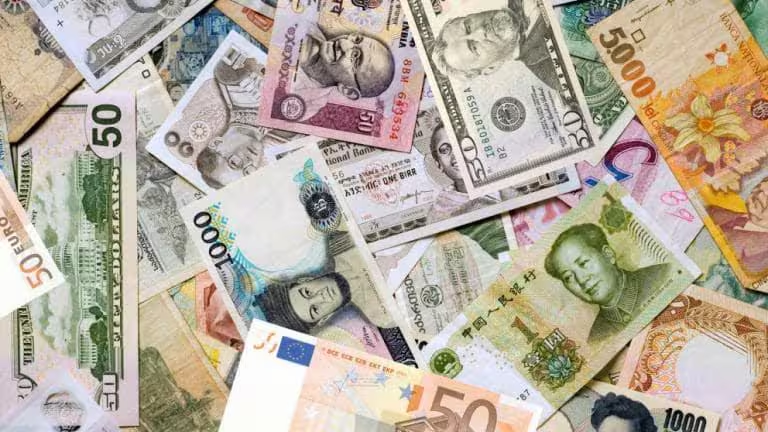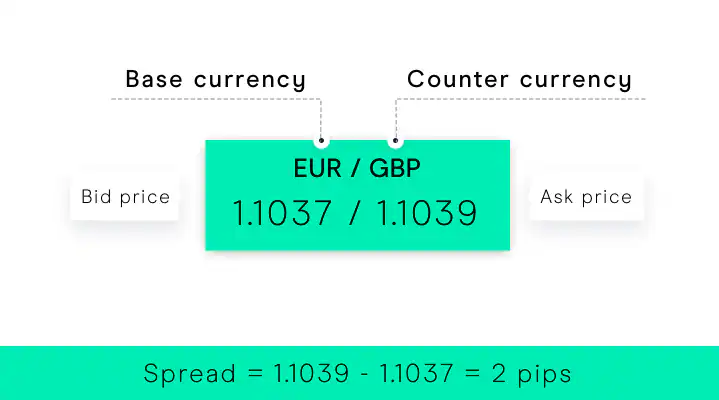Most forex currency pairs are traded without commission, but the spread is one cost that applies to any trade that you place. Rather than charging a commission, all leveraged trading providers will incorporate a spread into the cost of placing a trade, as they factor in a higher ask price relative to the bid price. The size of the spread can be influenced by different factors, such as which currency pair you are trading and how volatile it is, the size of your trade and which provider you are using.
Some of the major forex pairs include:
EUR/USD
USD/JPY
GBP/USD
USD/CHF
What does spread mean?
The spread is measured in pips, which is a small unit of movement in the price of a currency pair, and the last decimal point on the price quote (equal to 0.0001). This is true for the majority of currency pairs, aside from the Japanese yen where the pip is the second decimal point (0.01).
When there is a wider spread, it means there is a greater difference between the two prices, so there is usually low liquidity and high volatility. A lower spread on the other hand indicates low volatility and high liquidity. Thus, there will be a smaller spread cost incurred when trading a currency pair with a tighter spread.
When trading, the spread can either be variable or fixed. Indices, for example, have fixed spreads. The spread for forex pairs is variable, so when the bid and ask prices of the currency pair change, the spread changes too.
Some of the benefits and drawbacks of these two types of spreads are outlined below:
Fixed Spread | Variable Spread |
|---|
Could face requotes | No risk of requotes |
Predictable transaction costs | Can get a tighter spread than fixed |
Smaller capital requirements | Can reveal market liquidity |
More appropriate for novice traders | More appropriate for experienced traders |
A volatile market won't effect the spread | Spread can widen rapidly if there is high volatility |
Likely to be exposed to slippage | Can be exposed to slippage |
Spread calculator
The spread is calculated using the last large numbers of the buy and sell price, within a price quote. The last large number in the image below is a 3 and a 4. When trading forex, or any other asset via a CFD account, you pay the entire spread upfront. This compares to the commission paid when trading share CFDs, which is paid both when entering or exiting a trade. The tighter the spread, the better value you get as a trader.
For example:
The bid price is 1.26739 and the ask price is 1.26749 for the GBP/USD currency pair.
If you subtract 1.26739 from 1.26749, that equals 0.0001.
As the spread is based on the last large number in the price quote, it equates to a spread of 1.0.
Forex spread indicators
The spread indicator is typically displayed as a curve on a graph to show the direction of the spread as it relates to bid and ask price. This helps visualise the spread in the forex pair over time, with the most liquid pairs having tighter spreads and the more exotic pairs having wider spreads.
Factors which can influence the forex spread include market volatility, which can cause fluctuation. Major economic news, for example, can cause a currency pair to strengthen or weaken – thus affecting the spread. If the market is volatile, currency pairs can incur gapping, or the currency pair becomes less liquid, so the spread will widen.
Keeping an eye on an economic calendar can help prepare you for the possibility of wider spreads. By staying informed as to what events might cause currency pairs to become less liquid, you can make an educated prediction as to whether their volatility might increase, and thus whether you might see a greater spread. However, breaking news or unexpected economic data can be difficult to prepare for.
There will also be a lower spread for currency pairs traded in high volumes, such as the major pairs containing the USD. These pairs have higher liquidity but can still be at risk of widening spreads if there is economic volatility.
During the major market trading sessions, like London, New York and Sydney sessions, there are likely to be lower spreads. In particular, when there is an overlap, such as when the London session is ending and the New York session is beginning, the spread can be narrower still. The spread is also influenced by the general supply and demand of currencies – if there is a high demand for the euro, the value will increase.
Spread and margin
If the forex spread widens dramatically, you run the risk of receiving a margin call, and worst case, being liquidated. A margin call notification occurs when your account value drops below 100% of your margin level, signalling you’re at risk of no longer covering the trading requirement. If you reach 50% below the margin level, all your positions may be liquidated.
It’s therefore important to gauge how much leverage you’re trading with and the size of your position. Forex pairs are usually traded in larger amounts than shares, so it’s important to remain aware of your account balance.
Summary
A forex spread is the difference between the bid price and the ask price of a currency pair, and is usually measured in pips. Knowing what factors cause the spread to widen is crucial when trading forex. Major currency pairs are traded in high volumes so have a smaller spread, whereas exotic pairs will have a wider spread. See our guide on risk management when trading.
We offer competitive spreads on a range of currency pairs, including major pairs such as EUR/USD and GBP/USD. Visit our introduction guides learn more about forex pairs and to understand the factors that can affect them.
Discover forex trading with our award-winning trading platform.

